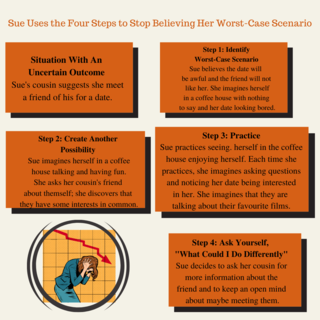Depression
Stop Believing Your Worst-Case Scenarios
Worst-case scenarios can happen, but so can best-case scenarios.
Posted April 15, 2021 Reviewed by Lybi Ma
Some of us are what I call “worst-case scenario” people. What is a worst-case scenario person? Let me introduce you to Sue. When Sue is in a situation where it is uncertain what the outcome will be, Sue tends to expect the worst. Since life is basically unpredictable, she spends a lot of time imagining worst-case scenarios. I call these her “Catastrophe Stories.” When she expects the worst, she feels depressed and anxious and then avoids the situation. Since she avoided the situation, she never gets to see if her negative predictions were accurate. Sue is caught in a worst-case scenario cycle.
Behind every worst-case scenario are two types of beliefs. The first is that we can’t cope with the situation, and the second is that generally the situation won’t turn out well for us and may even be catastrophic.
Let’s look at a situation in Sue’s life. Sue is in her mid-40s and works for an insurance company. She’s smart, but she tends to be quiet and doesn’t always share her ideas. She had a messy, awful divorce about three years ago. She’s lonely and would like to find a partner to share her life with. Her friends keep trying to set her up with different people, but she always says, “No, I’m not ready.” Sue is scared to try again. Underneath her “No” is the belief that: “No one will want to date me, it won’t work out, and I will be hurt again.” She paints a picture in her mind of an awful date where she has nothing to say and her date never wants to see her again. Now awful dates absolutely do occur, but Sue always goes to the worst-case scenario and forgets that there is another possibility, a best-case scenario, it is possible that she could have a lovely time.
How do you know if you are in a worst-case scenario cycle? And if you are, how do you get out of it? Here are four steps that can help you. Look at the figure that accompanies this post and you can see Sue’s four steps.

Step 1: Identify when you are in a worst-case scenario cycle. Here are some clues.
- Are you assuming that things won’t work out?
- Are you avoiding something that in your heart of hearts you know would be good for you? Are you stopping yourself because of your negative expectations?
- Do you use “What if…” thinking followed by a negative prediction?
Notice the details of the specific negative story you tell yourself. For example, do you imagine that you won’t get the job, that the new restaurant will not be any good, or that your child will not listen to you? Some people see their negative stories clearly happening in their mind’s eye. Often we are aware of our negative feelings, but we are unaware of the stories we tell ourselves until we stop and notice them.
Once you recognize that you are in a worst-case scenario cycle, give it a name. For example, are you being a Negative Sue or a Negative ______ (add your name)? Is there a cartoon character that reminds you of your negative cycle—maybe a grouch? What about calling it your “Catastrophe Story?” Giving this part of you a name can help you get some distance.
Step 2: Create another possibility. Once you have identified your Catastrophe Story, ask yourself if there is another possibility. Is there even a small likelihood that the outcome could be neutral or even positive? Remember, life is uncertain and unpredictable. Could you get the job interview or even get the job? Might the restaurant be delicious? And might your child listen to you?
You want to actively imagine a neutral or positive alternative that is still realistic. Try to really see the positive alternative happening. Make it as detailed as possible.
You don’t have to believe it; you just have to create it. Ask yourself the following questions:
- Might my predictions be wrong? Is there another neutral or more positive outcome that I am not considering?
- How would I think about this if I was in a positive mood?
- How would a friend or family member who believes in me think about this situation?
Step 3: Practice. Don’t try to stop thinking about your Catastrophe Story—when we try to stop thoughts, they just come back stronger—but gently put them aside and consciously imagine the alternative story. Imagine a film or video of the alternative story. Make it as detailed as possible.
Remember, you are not trying to convince yourself that your Catastrophe Story is wrong; you are just opening up the possibility of another more neutral or even positive outcome—a best-case scenario. The more you practice, and the more detailed the story, the more possible it will feel.
Step 4: Ask yourself, “What could I do differently?” Ask yourself, “How would I handle this situation if I believed the best-case scenario? What would be my first step?” You might even try imagining yourself taking the first step.
The next time you’re in a situation with an uncertain outcome, remember these four steps to breaking your worst-case scenario cycle—and start enjoying life more.
Take-Home Message:
- Recognize when you are in a worst-case scenario cycle—learn your own pattern.
- Create a neutral or positive alternative.
- Practice this alternative possibility, even if you don’t believe it.
- Ask yourself how you would behave if you believed this alternative possibility.
Remember: Life is unpredictable, your worst-case scenario can happen, but your best-case scenario can also happen.
References
In CBT Made Simple, you can find out more about how to identify your own worst-case scenario cycle, change your negative patterns, identify your Catastrophe Story, and create new, positive patterns.




